英汉委婉语的语用功能对比分析 开题报告
- 格式:doc
- 大小:42.50 KB
- 文档页数:2
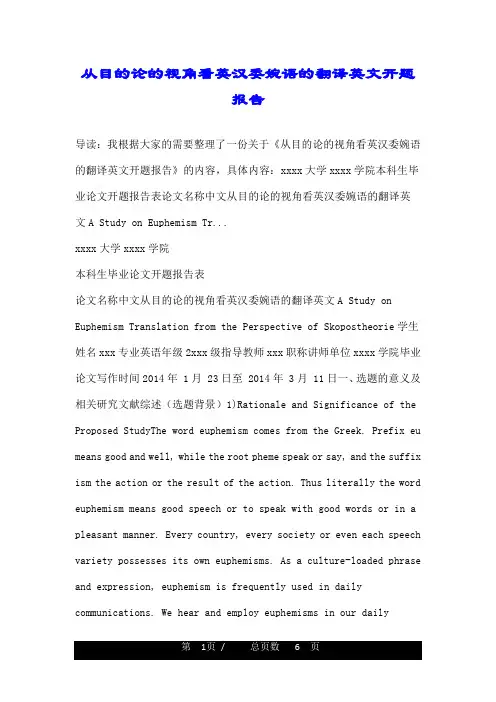
从目的论的视角看英汉委婉语的翻译英文开题报告导读:我根据大家的需要整理了一份关于《从目的论的视角看英汉委婉语的翻译英文开题报告》的内容,具体内容:xxxx大学xxxx学院本科生毕业论文开题报告表论文名称中文从目的论的视角看英汉委婉语的翻译英文A Study on Euphemism Tr...xxxx大学xxxx学院本科生毕业论文开题报告表论文名称中文从目的论的视角看英汉委婉语的翻译英文A Study on Euphemism Translation from the Perspective of Skopostheorie学生姓名xxx专业英语年级2xxx级指导教师xxx职称讲师单位xxxx学院毕业论文写作时间2014年 1月 23日至 2014年 3月 11日一、选题的意义及相关研究文献综述(选题背景)1)Rationale and Significance of the Proposed StudyThe word euphemism comes from the Greek. Prefix eu means good and well, while the root pheme speak or say, and the suffix ism the action or the result of the action. Thus literally the word euphemism means good speech or to speak with good words or in a pleasant manner. Every country, every society or even each speech variety possesses its own euphemisms. As a culture-loaded phrase and expression, euphemism is frequently used in daily communications. We hear and employ euphemisms in our dailycommunications. With the development of society and the progress of the human beings, international and intercultural communication and cooperation is becoming more and more intensive and frequent. However, the translation of euphemisms often challenges a translators wits. Sometimes the word meaning from bilingual dictionaries can hardly convey the writers implication and inspiration. Euphemisms should be translated in a appropriate and accurate way. For this reason, the thesis aims to study the euphemism translation from a new perspective—Skopostheorie, which will provide a much more extensive horizon for and give more enlightenment on euphemism translation.2)Literature Review (Background)As a common language phenomenon, euphemism has long been an interesting topic, which has attracted both home and abroad scholars attention and concern. They have conducted a lots of studies related to euphemism translation from different perspectives. Liu "(Liu Hongwei, 2009)" studied the feasibility of the application of functional equivalence theory to the translation between English and Chinese euphemism and probed its translation techniques. While Wang "(Wang Chunna, 2008)" analyzed the translation of euphemism from the angle of culture and pointed out the importance of the factor of culture in euphemism translation. Zhang "(Zhang Luodan, 2004)" adopted a pragmatic approach to accountfor the practice, features and functions of English euphemisms in language communication. They have contributed a great deal to this research area. But there are still some space for the study of euphemism translation between English and Chinese. Skopostheorie, a new perspective, will provide a much more extensive horizon for and give some enlightenment on euphemism translation.二、研究的主要内容(研究问题)、预期目标(工作假设)以及可能遇到的困难1)Research QuestionsWhether the euphemism translation has specific strategyHow to employ Hans Vermeers Skopostheorie to conduct euphemism translation2)Aims and ObjectivesAttempt to explain and solve the following aspects:Euphemism translation has specific strategyHans Vermeers Skopostheorie can be applied to conduct euphemism translation3)Potential DifficultiesDuring the process of analysis, some foreign language materials may be difficult to collect or materials are incomplete. It is hard to provide concrete examples in order to bridge theory and practice.三、拟采用的理论框架及/或研究方法、步骤1)Theoretical FrameworkSkopostheorie is the fundamental theory of functionalist translation. Functionalist translation includes macro functionalist translation centered on German functionalist translation, and micro functionalist translation based on Hallidays systematic functional grammar. This thesis will talk about euphemism translation from the perspectiveof the micro functionalist translation. The functionalist translation theory came into being in 1970s in Germany, and there have been three distinguished contributors to the formation of this theory: Katharine Reiss, Hans J. Vermeer and Christiane Nord (Bian, qtd. in HAN, 2011: 17). Hans J. Vermeer, the student of Reiss, gives up the source-text centered linguistic translation theory altogether and develops his theory of translation as an intentional action guided by its purpose. He makes a breakthrough by putting forward his famous Skopostheorie in 1978, which is regarded as the landmark of functional translation. Skopos is a Greek word for "purpose", and Skopostheorie means the theory of purposeful action. Skopostheorie includes three principal rules, the skopos rule, the coherence rule (intratextual coherence) and fidelity rule (intertextual coherence).2)Methodology and Data CollectionLiterature Research MethodLiterature research method means finding related periodical literature and books by means of database. Through this method, the history and current situation of euphemism translation can be understood and help the author have comprehensive perspective to solve the problems related to euphemism translation.Qualitative MethodQualitative method means employing induction and deduction, analysis and synthesis, abstract and generalization to integrate the date that have been collected.Thus, the dross can be rejected and the fine essence can be assimilated and help the author recognize the nature of euphemism and reveal the inherent law of euphemism translation.Descriptive MethodDescriptive method means describing and explaining the Skopostheorie through the authors understandings. Thus the author can effectively combine with theoretical analysis to conduct the study on euphemism translation.3)Stepsliterature screening literature reading literature arrangement analyze and determine the relation between literature and selected topic initially determine the basic framework thesis writing 四、论文提纲、总体时间安排与进度(阶段性完成的任务,以周计算)Outline/Organization of the Proposed Study1.Introduction1.1 Rationale and Significance1.2 Research Design1.2.1 Research Questions1.2.2 Research Methods1.2.3 Date Collection1.4 Organization of the Dissertation2.Literature Review2.1 Previous Research on Euphemism Studies2.2 Previous Research on the Application of the Skopostheorie to Euphemism Translation Studies2.3 Achievements and Drawbacks3.Theoretical Framework3.1 An Overview of the Skopostheorie3.2 Basic Concepts of the Skopostheorie3.2.1 The Skopos Rule3.2.2 The Coherence Rule3.2.3 The Fidelity Rule3.3 The Application of Skopostheorie to Euphemism Translation4.Case Study4.1 Euphemism Translation and SkoposRule4.2 Euphemism Translation and Coherence Rule4.3 EuphemismTranslation and Fidelity Rule5.Discussion6.ConclusionReferences 2.Time Arrangement and ScheduleOverall Processing Time: Four Months (calculating from February, 2014)Schedule: First Draft before 10th, March, 2014Second Draft before 14th, April, 2014Final Draft before 12th, May, 2014Thesis Defense Preparation from 13th, May to 23rd, May五、初期参考文献(10,必须包括book及article)ReferencesFu Peng. Euphemism Translation in the Light of Skopostheorie. M.A. Zhejiang Normal University, 2008.HAN Xiang-hua. On Translation of English Euphemism from Skopostheorie. M.A. Henan University of Technology, 2011.Zhang Luodan. A Pragmatic Study on English Euphemisms. M.A. Jilin University, 2004.Zhao Zihui. A Research on the Translation of Diplomatic Euphemisms at Press Conference. M.A. North University of China, 2012.卞建华(Bian Jianhua). 传承与超越:功能主义翻译目的论研究. 北京:中国社会科学出版社. 2008.戴聪腾(Dai Congteng). 论英汉委婉语的差异和翻译对策. 福建医科大学学报, 第3卷. 2002: 81-85.高微微(Gao Weiwei). 目的论视角下委婉语的翻译. 牡丹江教育学院学报, 第6期. 2006: 56-57.刘弘玮(Liu Hongwei). "功能对等"视角下的英汉委婉语翻译. 宜春学院学报, 第31卷. 2009: 64-66.孙展(Sun Zhan). 目的论视角下的委婉语翻译研究—以美剧《生活大爆炸》为个案研究. 硕士论文. 福建师范大学, 2012.王春娜(Wang Chunna). 文化因素对委婉语翻译的影响. 沈阳大学学报, 第20卷. 2008: 60-63.六、指导教师意见指导教师签名:年月日七、学院论文评审委员会意见盖章年月日。

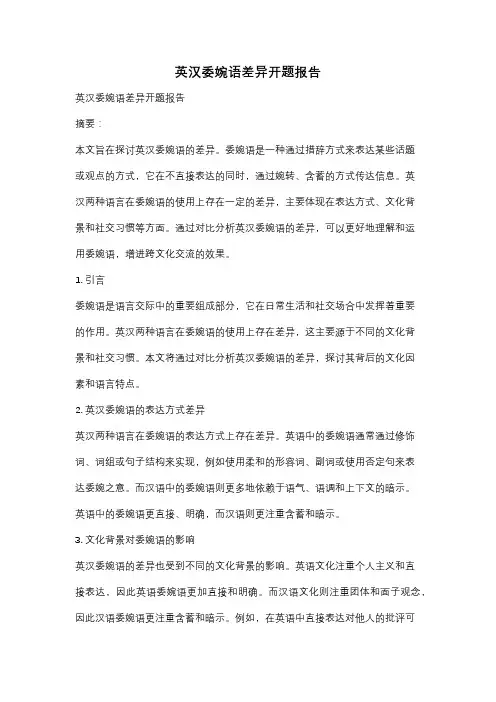
英汉委婉语差异开题报告英汉委婉语差异开题报告摘要:本文旨在探讨英汉委婉语的差异。
委婉语是一种通过措辞方式来表达某些话题或观点的方式,它在不直接表达的同时,通过婉转、含蓄的方式传达信息。
英汉两种语言在委婉语的使用上存在一定的差异,主要体现在表达方式、文化背景和社交习惯等方面。
通过对比分析英汉委婉语的差异,可以更好地理解和运用委婉语,增进跨文化交流的效果。
1. 引言委婉语是语言交际中的重要组成部分,它在日常生活和社交场合中发挥着重要的作用。
英汉两种语言在委婉语的使用上存在差异,这主要源于不同的文化背景和社交习惯。
本文将通过对比分析英汉委婉语的差异,探讨其背后的文化因素和语言特点。
2. 英汉委婉语的表达方式差异英汉两种语言在委婉语的表达方式上存在差异。
英语中的委婉语通常通过修饰词、词组或句子结构来实现,例如使用柔和的形容词、副词或使用否定句来表达委婉之意。
而汉语中的委婉语则更多地依赖于语气、语调和上下文的暗示。
英语中的委婉语更直接、明确,而汉语则更注重含蓄和暗示。
3. 文化背景对委婉语的影响英汉委婉语的差异也受到不同的文化背景的影响。
英语文化注重个人主义和直接表达,因此英语委婉语更加直接和明确。
而汉语文化则注重团体和面子观念,因此汉语委婉语更注重含蓄和暗示。
例如,在英语中直接表达对他人的批评可能被视为坦率,而在汉语中,这种直接表达可能会被视为失礼和冒犯。
4. 社交习惯对委婉语的影响社交习惯也是英汉委婉语差异的重要因素。
英语社交习惯中,人们更倾向于直接交流和表达自己的意见,因此英语委婉语相对较少。
而在汉语社交习惯中,人们更注重面子和社会关系,因此更倾向于使用委婉语来避免冲突和尴尬。
这种社交习惯的差异也导致了英汉委婉语的差异。
5. 对英汉委婉语差异的启示对英汉委婉语差异的深入理解可以帮助我们更好地进行跨文化交流。
在与英语母语者交流时,我们可以更直接、明确地表达自己的意见。
而在与汉语母语者交流时,我们应该更加注重语气、语调和上下文的暗示,尽量避免直接表达对他人的批评或负面评价。
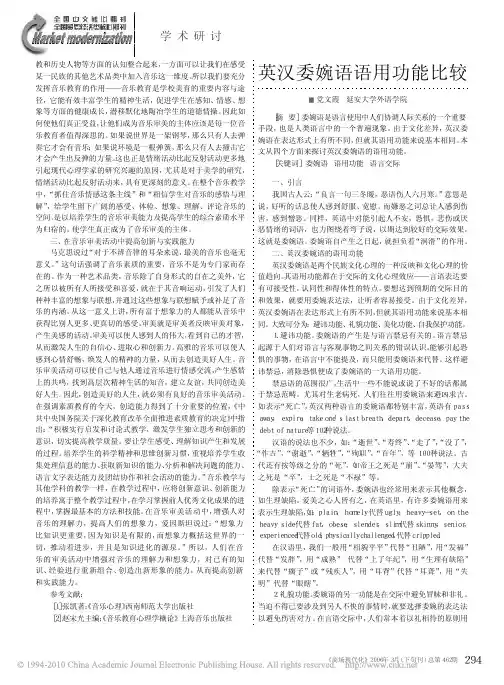
《商场现代化》2006年3月(下旬刊)总第462期294教和历史人物等方面的认知整合起来,一方面可以让我们在感受某一民族的其他艺术品类中加入音乐这一维度。
所以我们要充分发挥音乐教育的作用——音乐教育是学校美育的重要内容与途径,它能有效丰富学生的精神生活,促进学生在感知、情感、想象等方面的健康成长,潜移默化地陶冶学生的道德情操。
因此如何使他们真正受益,让他们成为音乐审美的主体应该是每一位音乐教育者值得深思的。
如果说世界是一架钢琴,那么只有人去弹奏它才会有音乐;如果说环境是一根弹簧,那么只有人去撞击它才会产生出反弹的力量。
这也正是情绪活动比起反射活动更多地引起现代心理学家的研究兴趣的原因,尤其是对于美学的研究,情绪活动比起反射活动来,具有更深刻的意义。
在整个音乐教学中,“抓住音乐情感这条主线”和“相信学生对音乐的感悟与理解”,给学生留下广阔的感受、体验、想象、理解、评论音乐的空间。
是以培养学生的音乐审美能力及提高学生的综合素质水平为归宿的。
使学生真正成为了音乐审美的主体。
三、在音乐审美活动中提高创新与实践能力马克思说过“对于不辨音律的耳朵来说,最美的音乐也毫无意义。
”这句话强调了音乐素质的重要,音乐不是为专门家而存在的。
作为一种艺术品类,音乐除了自身形式的自在之美外,它之所以被所有人所接受和喜爱,就在于其音响运动,引发了人们种种丰富的想象与联想,并通过这些想象与联想赋予或补足了音乐的内涵。
从这一意义上讲,所有富于想象力的人都能从音乐中获得比别人更多、更真切的感受。
审美就是审美者反映审美对象,产生美感的活动。
审美可以使人感到人的伟大,看到自己的才智,从而激发人生的自信心、进取心和创新力。
高雅的音乐可以使人感到心情舒畅,焕发人的精神的力量,从而去创造美好人生。
音乐审美活动可以使自己与他人通过音乐进行情感交流,产生感情上的共鸣,找到高层次精神生活的知音,建立友谊,共同创造美好人生。
因此,创造美好的人生,就必须有良好的音乐审美活动。
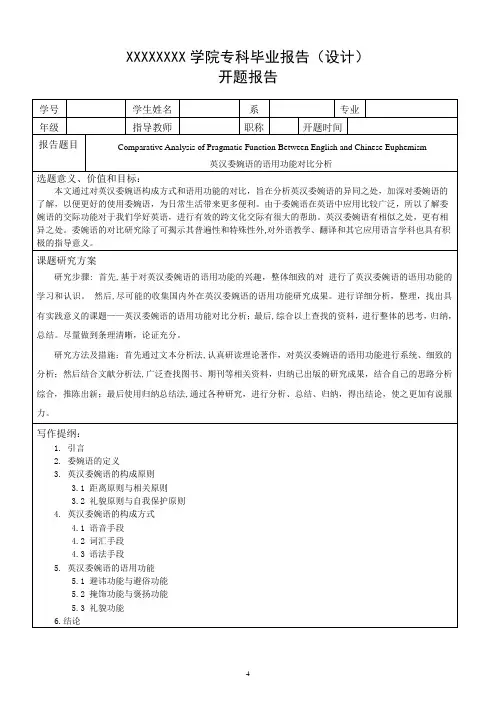
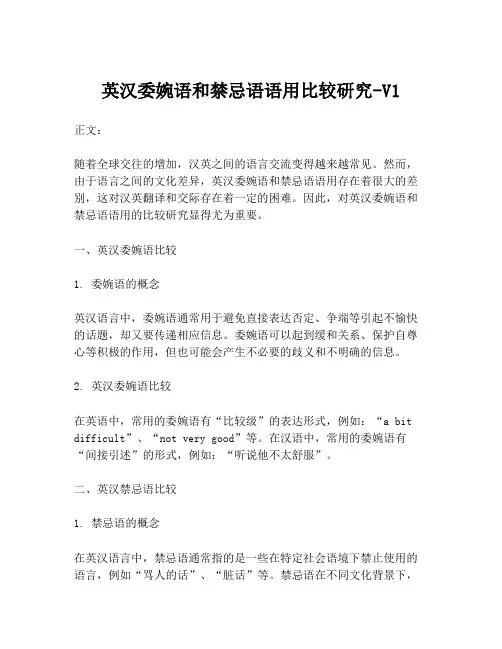
英汉委婉语和禁忌语语用比较研究-V1正文:
随着全球交往的增加,汉英之间的语言交流变得越来越常见。
然而,由于语言之间的文化差异,英汉委婉语和禁忌语语用存在着很大的差别,这对汉英翻译和交际存在着一定的困难。
因此,对英汉委婉语和禁忌语语用的比较研究显得尤为重要。
一、英汉委婉语比较
1. 委婉语的概念
英汉语言中,委婉语通常用于避免直接表达否定、争端等引起不愉快的话题,却又要传递相应信息。
委婉语可以起到缓和关系、保护自尊心等积极的作用,但也可能会产生不必要的歧义和不明确的信息。
2. 英汉委婉语比较
在英语中,常用的委婉语有“比较级”的表达形式,例如:“a bit difficult”、“not very good”等。
在汉语中,常用的委婉语有“间接引述”的形式,例如:“听说他不太舒服”。
二、英汉禁忌语比较
1. 禁忌语的概念
在英汉语言中,禁忌语通常指的是一些在特定社会语境下禁止使用的语言,例如“骂人的话”、“脏话”等。
禁忌语在不同文化背景下,
其表达方式和表现力也有很大的差别。
2. 英汉禁忌语比较
在英语中,禁忌语属于一种口语化的表达方式,而在汉语中,禁忌语的使用属于一种文化上的禁忌,常常与道德与文化价值观有关。
结论:
经过英汉委婉语和禁忌语语用比较研究,我们发现,英汉语言之间存在很大的差异。
对于翻译和交际,我们需要注意语言和文化之间的差异,学习和掌握不同文化背景下的语言使用方式,才能够更好地促进英汉之间的交流和理解。
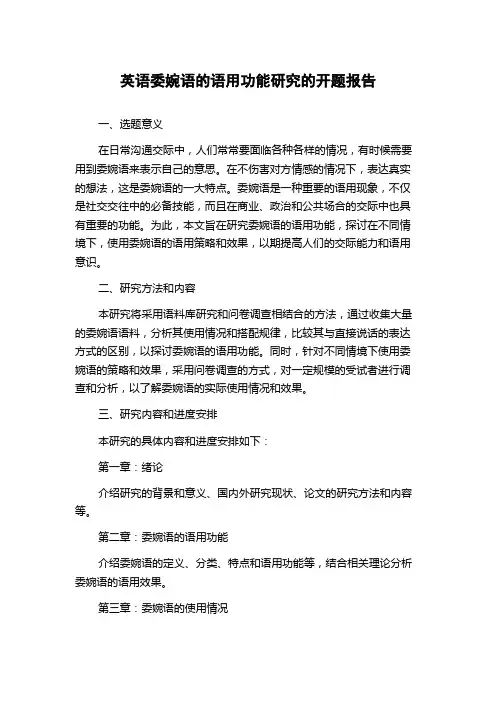
英语委婉语的语用功能研究的开题报告一、选题意义在日常沟通交际中,人们常常要面临各种各样的情况,有时候需要用到委婉语来表示自己的意思。
在不伤害对方情感的情况下,表达真实的想法,这是委婉语的一大特点。
委婉语是一种重要的语用现象,不仅是社交交往中的必备技能,而且在商业、政治和公共场合的交际中也具有重要的功能。
为此,本文旨在研究委婉语的语用功能,探讨在不同情境下,使用委婉语的语用策略和效果,以期提高人们的交际能力和语用意识。
二、研究方法和内容本研究将采用语料库研究和问卷调查相结合的方法,通过收集大量的委婉语语料,分析其使用情况和搭配规律,比较其与直接说话的表达方式的区别,以探讨委婉语的语用功能。
同时,针对不同情境下使用委婉语的策略和效果,采用问卷调查的方式,对一定规模的受试者进行调查和分析,以了解委婉语的实际使用情况和效果。
三、研究内容和进度安排本研究的具体内容和进度安排如下:第一章:绪论介绍研究的背景和意义、国内外研究现状、论文的研究方法和内容等。
第二章:委婉语的语用功能介绍委婉语的定义、分类、特点和语用功能等,结合相关理论分析委婉语的语用效果。
第三章:委婉语的使用情况收集大量的委婉语语料,分析其使用情况和搭配规律,比较其与直接说话的表达方式的区别,探讨委婉语使用的实际情况和效果。
第四章:委婉语的语用策略探讨在不同情境下使用委婉语的语用策略,分析委婉语的使用效果和应用价值。
第五章:问卷调查分析针对不同人群进行问卷调查,分析委婉语在实际交际中的使用情况,了解委婉语的实际效果和应用价值。
第六章:结论总结研究结果,提出相关建议,展望委婉语在实际交际中的应用前景。
四、研究实施的可行性、难点和解决途径本研究采用语料库研究和问卷调查相结合的方法,数据收集和分析的可行性较高,具有较高的科学性和可靠性。
但是,难点主要在于如何有效收集到大量标准规范的委婉语语料,以及如何设计能够代表不同人群的问卷调查。
为了解决这些难点,可以采用以下途径:1、利用网络、书籍、语料库等途径,收集大量的委婉语语料,并进行筛选和整理。
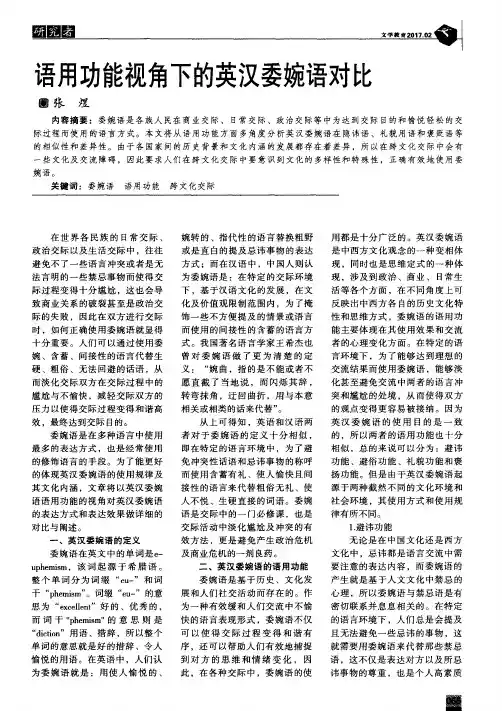
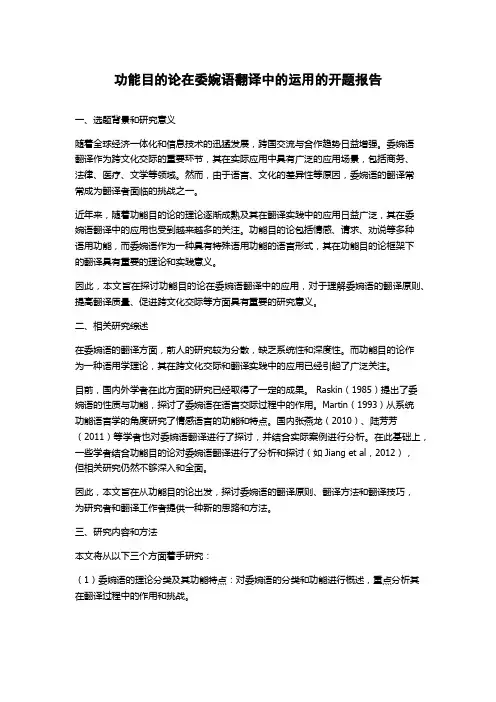
功能目的论在委婉语翻译中的运用的开题报告一、选题背景和研究意义随着全球经济一体化和信息技术的迅猛发展,跨国交流与合作趋势日益增强。
委婉语翻译作为跨文化交际的重要环节,其在实际应用中具有广泛的应用场景,包括商务、法律、医疗、文学等领域。
然而,由于语言、文化的差异性等原因,委婉语的翻译常常成为翻译者面临的挑战之一。
近年来,随着功能目的论的理论逐渐成熟及其在翻译实践中的应用日益广泛,其在委婉语翻译中的应用也受到越来越多的关注。
功能目的论包括情感、请求、劝说等多种语用功能,而委婉语作为一种具有特殊语用功能的语言形式,其在功能目的论框架下的翻译具有重要的理论和实践意义。
因此,本文旨在探讨功能目的论在委婉语翻译中的应用,对于理解委婉语的翻译原则、提高翻译质量、促进跨文化交际等方面具有重要的研究意义。
二、相关研究综述在委婉语的翻译方面,前人的研究较为分散,缺乏系统性和深度性。
而功能目的论作为一种语用学理论,其在跨文化交际和翻译实践中的应用已经引起了广泛关注。
目前,国内外学者在此方面的研究已经取得了一定的成果。
Raskin(1985)提出了委婉语的性质与功能,探讨了委婉语在语言交际过程中的作用。
Martin(1993)从系统功能语言学的角度研究了情感语言的功能和特点。
国内张燕龙(2010)、陆芳芳(2011)等学者也对委婉语翻译进行了探讨,并结合实际案例进行分析。
在此基础上,一些学者结合功能目的论对委婉语翻译进行了分析和探讨(如Jiang et al,2012),但相关研究仍然不够深入和全面。
因此,本文旨在从功能目的论出发,探讨委婉语的翻译原则、翻译方法和翻译技巧,为研究者和翻译工作者提供一种新的思路和方法。
三、研究内容和方法本文将从以下三个方面着手研究:(1)委婉语的理论分类及其功能特点:对委婉语的分类和功能进行概述,重点分析其在翻译过程中的作用和挑战。
(2)功能目的论在委婉语翻译中的应用:以情感、请求、劝说等功能为例,从功能目的论的角度探讨委婉语的翻译方法和技巧。
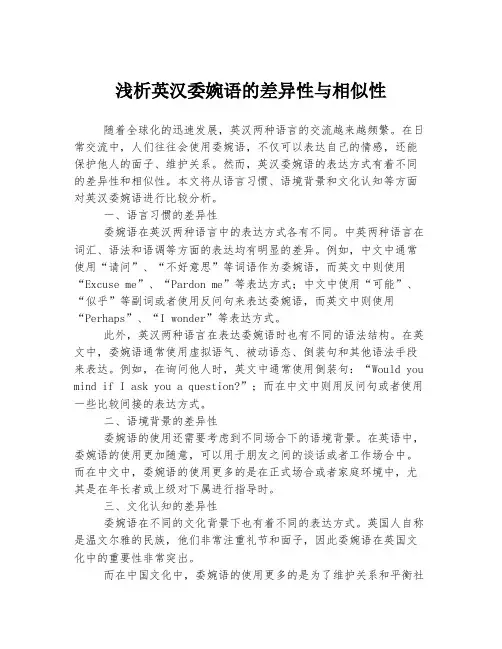
浅析英汉委婉语的差异性与相似性随着全球化的迅速发展,英汉两种语言的交流越来越频繁。
在日常交流中,人们往往会使用委婉语,不仅可以表达自己的情感,还能保护他人的面子、维护关系。
然而,英汉委婉语的表达方式有着不同的差异性和相似性。
本文将从语言习惯、语境背景和文化认知等方面对英汉委婉语进行比较分析。
一、语言习惯的差异性委婉语在英汉两种语言中的表达方式各有不同。
中英两种语言在词汇、语法和语调等方面的表达均有明显的差异。
例如,中文中通常使用“请问”、“不好意思”等词语作为委婉语,而英文中则使用“Excuse me”、“Pardon me”等表达方式;中文中使用“可能”、“似乎”等副词或者使用反问句来表达委婉语,而英文中则使用“Perhaps”、“I wonder”等表达方式。
此外,英汉两种语言在表达委婉语时也有不同的语法结构。
在英文中,委婉语通常使用虚拟语气、被动语态、倒装句和其他语法手段来表达。
例如,在询问他人时,英文中通常使用倒装句:“Would you mind if I ask you a question?”;而在中文中则用反问句或者使用一些比较间接的表达方式。
二、语境背景的差异性委婉语的使用还需要考虑到不同场合下的语境背景。
在英语中,委婉语的使用更加随意,可以用于朋友之间的谈话或者工作场合中。
而在中文中,委婉语的使用更多的是在正式场合或者家庭环境中,尤其是在年长者或上级对下属进行指导时。
三、文化认知的差异性委婉语在不同的文化背景下也有着不同的表达方式。
英国人自称是温文尔雅的民族,他们非常注重礼节和面子,因此委婉语在英国文化中的重要性非常突出。
而在中国文化中,委婉语的使用更多的是为了维护关系和平衡社会关系。
在中国的文化中,“面子”更是一种无形的价值,是社会生活中不可或缺的要素。
因此,在面对冲突或者不愉快的事情时,中国人通常会使用委婉语来保护对方的面子,避免矛盾升级。
总之,英汉委婉语的差异性和相似性有着不同的表现形式。
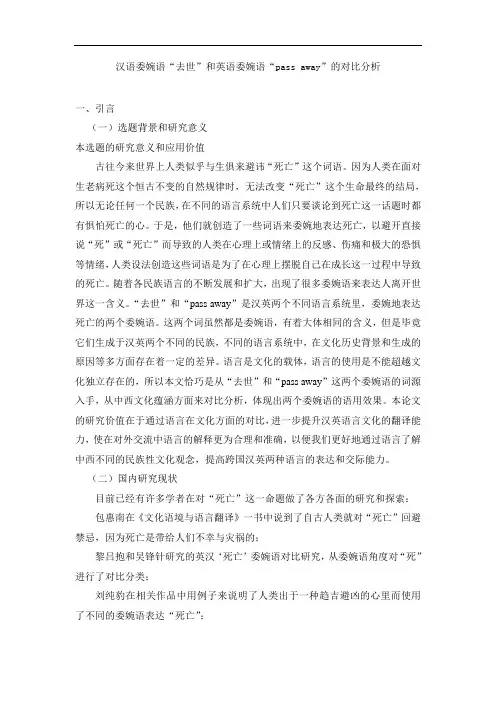
汉语委婉语“去世”和英语委婉语“pass away”的对比分析一、引言(一)选题背景和研究意义本选题的研究意义和应用价值古往今来世界上人类似乎与生俱来避讳“死亡”这个词语。
因为人类在面对生老病死这个恒古不变的自然规律时,无法改变“死亡”这个生命最终的结局,所以无论任何一个民族,在不同的语言系统中人们只要谈论到死亡这一话题时都有惧怕死亡的心。
于是,他们就创造了一些词语来委婉地表达死亡,以避开直接说“死”或“死亡”而导致的人类在心理上或情绪上的反感、伤痛和极大的恐惧等情绪,人类设法创造这些词语是为了在心理上摆脱自己在成长这一过程中导致的死亡。
随着各民族语言的不断发展和扩大,出现了很多委婉语来表达人离开世界这一含义。
“去世”和“pass away”是汉英两个不同语言系统里,委婉地表达死亡的两个委婉语。
这两个词虽然都是委婉语,有着大体相同的含义,但是毕竟它们生成于汉英两个不同的民族,不同的语言系统中,在文化历史背景和生成的原因等多方面存在着一定的差异。
语言是文化的载体,语言的使用是不能超越文化独立存在的,所以本文恰巧是从“去世”和“pass away”这两个委婉语的词源入手,从中西文化蕴涵方面来对比分析,体现出两个委婉语的语用效果。
本论文的研究价值在于通过语言在文化方面的对比,进一步提升汉英语言文化的翻译能力,使在对外交流中语言的解释更为合理和准确,以便我们更好地通过语言了解中西不同的民族性文化观念,提高跨国汉英两种语言的表达和交际能力。
(二)国内研究现状目前已经有许多学者在对“死亡”这一命题做了各方各面的研究和探索:包惠南在《文化语境与语言翻译》一书中说到了自古人类就对“死亡”回避禁忌,因为死亡是带给人们不幸与灾祸的;黎吕抱和吴锋针研究的英汉‘死亡’委婉语对比研究,从委婉语角度对“死”进行了对比分类;刘纯豹在相关作品中用例子来说明了人类出于一种趋吉避凶的心里而使用了不同的委婉语表达“死亡”;程国富在期刊《汉字文化》上发表的文章里面列出了英语表达“死亡”汉语里没有的委婉表达,而在汉语里有些独有的委婉表达又是英语里没有的;史菊桂在跨文化比较研究的论文里,从中西两种不同文化背景比较了死亡的委婉语背后的文化现象;赵雄、何翔如在校刊上发表的《英汉语中“死”的表达法之比较》一文里从褒义、中性以及贬义三个词性方面比较了“死亡”的表达方式;朱安兴在发表的《英语中“死”之异称》文章里列出了英语中215个表达“死亡”的异称,是汉语里没有的表达方式;望经纬在浅析汉英委婉语中认为因阶级性、价值观念的不同而产生了不同的表达“死亡”的委婉语;刘秀明、刘春蓉发表的文章中认为中西对待死亡的态度相似,为国而死的死亡观念,其委婉表达的共性是都具有褒义色彩,而死亡委婉语的个性方面就是名族的差异性和表达的不同。
外国语学院毕业论文开题报告专业:学生姓名:班级:指导教师:开题日期: 2012年3月8日论文题目The Communicative Function and Translation Skills of the English Euphemism英语委婉语的交际功能及翻译技巧一、本选题的目的和意义委婉语不仅是调节、建构人际关系的一种重要手段,而且是人际关系的存在方式。
委婉语既是语言修辞的结晶,又是社会文化的积淀。
委婉语体现了语境和社会文化对使用语言的制约和影响, 也体现了不同民族对交际方式的要求。
随着社会的进步,人类文明的发展,委婉语始终伴随着整个社会的言语交际过程,且充分显示了它的交际功能。
本文从委婉语在英美国家的使用情形这一角度出发,着重探讨了委婉语的避讳功能、礼貌功能、掩饰功能、劝诱功能和幽默功能。
具体分析了每一个功能的内涵意义及其在交际中的具体表现,并重点研究了委婉语在跨文化交际中,用于不同交际功能时最恰当的翻译技巧和方法。
委婉语在各个领域都有广泛的应用,所以了解委婉语的交际功能及翻译技巧将有助于我们在跨文化交际中更加自觉和准确的使用语言,对我们学好英语,进行有效的跨文化交际有很大的帮助,并且对我们今后的外语教学、翻译和其他应用语言学科具有积极的指导作用。
二、本选题相关领域研究的现状及基本情况早在16世纪80年代初,英国作家George Blunt首创了euphemism一词,并将其定义为“a good or favorable interpretation of a bad word”。
此后,美国语言学家Menken结合美国社会的历史文化背景,讨论了几百个英语委婉语的产生和流行的原因。
英国语言学家Hugh Rawson(1981)编纂出版的A Dictionary of Euphemisms and Other Doubletalk追溯了委婉语的研究历史,而且对委婉语的特点、定义、分类、涉及范围等诸多问题进行了广泛的讨论。
英汉委婉语之对比研究一、本文概述委婉语,作为一种普遍存在的语言现象,其运用广泛且历史悠久。
在英汉两种语言中,委婉语都扮演着重要的角色,它们不仅体现了语言的艺术性和丰富性,更反映了社会文化的深层内涵。
本文旨在对比研究英汉委婉语的使用情况,探讨其背后的文化差异和社会因素,以期加深对两种语言及文化的理解和认识。
文章将首先对委婉语的定义和特征进行概述,明确研究范围和对象。
接着,通过对比分析英汉委婉语在各个领域(如社交、政治、经济、医疗等)的使用情况,揭示两种语言委婉语表达方式的异同。
在此基础上,文章将进一步探讨英汉委婉语形成的文化根源和社会背景,分析影响委婉语使用的诸多因素,如宗教信仰、道德观念、价值观等。
文章将总结英汉委婉语对比研究的意义和价值,以及对跨文化交流的实际应用和指导意义。
通过本文的研究,我们期望能够更深入地理解英汉委婉语的文化内涵和社会功能,为跨文化交流提供有益的参考和启示。
也希望本文的研究能够推动语言学和文化学领域的进一步发展,为相关学科的研究提供新的视角和思路。
二、委婉语的定义与分类委婉语作为一种语言现象,普遍存在于各种语言和文化之中。
其核心目的是通过使用柔和、含蓄或模糊的词汇和表达方式,以避免直接提及某些可能令人不适或尴尬的词汇或概念。
委婉语不仅仅是一种语言技巧,更是一种社会文化的反映,体现了人们对某些敏感话题或情境的回避和尊重。
定义:委婉语通常被定义为一种避免直接提及某些令人不悦、尴尬或冒犯性话题的语言手段。
通过使用委婉语,人们可以在不直接暴露或强调某些不愉快或敏感信息的情况下进行交流。
这种语言策略不仅在日常对话中广泛使用,也在正式场合和文学作品中占有一席之地。
分类:委婉语的分类多种多样,但常见的分类方式主要基于其使用目的和所涉及的话题。
避讳性委婉语:这种委婉语主要用于避免提及某些令人不悦或尴尬的事实,如死亡、疾病、残疾等。
例如,在英语中,“pass away”或“depart this life”被用来代替“die”,而中文中则常用“仙逝”“过世”等词汇。
中英委婉语的对比分析中文委婉语和英文委婉语在表达方式上都有一定的差异。
在中文中,委婉语通常以陈述句的形式出现,而在英文中则更多地使用疑问句或借助动词来表达委婉之意。
此外,中英文委婉语在表达场合、语气和目的等方面也有所不同。
以下是中英文委婉语的对比分析。
1.表达场合在表达场合上,中英文委婉语的使用情况有所不同。
在中文中,委婉语常见于礼貌场合,如商务会议、婚礼、葬礼、生日宴会等。
在英文中,委婉语也常用于礼貌场合,但更多地用于表达不好的消息或请求时,例如道歉、拒绝、讨论敏感话题等。
2.表达语气中英文委婉语在语气上也有所不同。
在中文中,委婉语通常以平和的口吻表达,不会给人强烈的情感冲击;而在英文中,委婉语往往会带有一定的情感色彩,比如伤心、生气、失望等,以表达说话人的真实感受。
3.表达目的中英文委婉语在表达目的上也存在区别。
在中文中,委婉语常用于掩饰客观事实或在避免伤害他人的同时传递特定的信息;在英文中,委婉语则更多地用于缓和紧张气氛、调解冲突或避免争吵。
4.表达方式中英文委婉语的表达方式也各不相同。
中文委婉语多采用陈述句的形式表达,例如“真的不方便”、“人比较多”等;而英文委婉语则常用疑问句或借助动词的方式来表达,例如“Do you think it might be possible...”、“Could you possibly...”等。
总体而言,中英文委婉语在表达方式、语气、适用场合、表达目的等方面都有所不同。
在日常交流中,我们需根据实际情况,选择合适的委婉语表达方式,以达到良好的交流效果。
英汉死亡委婉语的隐喻研究的开题报告题目:英汉死亡委婉语的隐喻研究摘要:本文旨在探讨英汉文化中的死亡委婉语,特别是其所涉及的隐喻,并通过对比分析两种语言中常见的隐喻表达方式,揭示其文化差异和共性。
本研究将采用语料库分析法和对比分析法,进一步探究该领域的相关问题。
关键词:死亡委婉语、隐喻、语料库分析、对比分析1. 研究背景和意义死亡是人类普遍面临的现实问题,而如何表达死亡则是不同文化传统习惯的体现。
委婉语是人类语言中普遍存在的一种表达形式,在死亡方面也有其特殊用途。
虽然英汉两种语言都有死亡委婉语,但其隐喻表达方式存在一定的差异,这与其文化背景有关。
本研究旨在通过对比分析英汉语言中常见的死亡委婉语隐喻表达方式,探讨英汉语言中死亡委婉语隐喻的文化差异和共性,有助于加深人们对不同文化间的认识和理解。
此外,随着全球化的发展,越来越多的人们开始学习和使用多种语言,对跨文化交际的需求也日益增加。
因此,对于不同文化背景下的委婉语表达方式的研究,对于促进跨文化交流和理解具有重要意义。
2. 研究方法与过程本研究将采用语料库分析法和对比分析法。
首先,使用现有的英语和汉语死亡委婉语语料库,提取其中常见的隐喻表达方式,并按照语义类别进行分类。
对于英语和汉语中常见的隐喻,应尽可能地将其译成可以互相比较的形式。
其次,将提取的隐喻表达方式进行对比分析,探讨两种语言中的委婉语隐喻的文化差异和共性。
对于比较中出现的问题和现象,应结合文化背景和语言习惯进行分析和解释,并说明其影响和意义。
最后,分析研究结果,提出相关结论和建议。
3. 预期成果和意义本研究的预期成果包括:(1)阐述英汉文化中的死亡委婉语及其隐喻表达方式,包括转喻、拟人化、比喻等。
(2)对比分析两种语言中常见的隐喻表达方式,揭示其文化差异和共性,分析其影响和意义。
(3)提供相关建议,促进跨文化交流和理解。
通过对死亡委婉语隐喻的研究,可以使读者更深入地理解和认识英汉文化背景下死亡委婉语的相似与不同,有助于促进人类间的跨文化交流和理解。